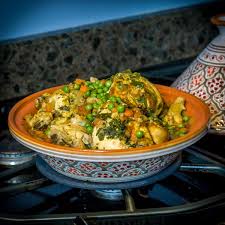The Art of Cooking a Traditional Tagine
Tagine, a North African dish named after the earthenware pot it is cooked in, is a culinary delight that tantalises the taste buds with its rich flavours and aromatic spices. This traditional dish has been enjoyed for centuries and continues to be a staple in Moroccan cuisine.
Ingredients:
- 500g lamb or chicken, cut into pieces
- 2 onions, finely chopped
- 3 cloves of garlic, minced
- 2 tomatoes, diced
- A handful of green olives
- A preserved lemon, sliced
- A bunch of fresh coriander, chopped
- A mix of Moroccan spices (cumin, paprika, ginger, turmeric)
- Salt and pepper to taste
- Olive oil for cooking
Instructions:
- Heat olive oil in the tagine pot over medium heat.
- Add the chopped onions and garlic, sauté until golden brown.
- Add the meat pieces and brown them on all sides.
- Sprinkle the Moroccan spices over the meat and mix well.
- Add the diced tomatoes and allow them to soften.
- Pour enough water to cover the meat and bring it to a simmer.
- Cover the tagine pot with its conical lid and let it cook on low heat for about an hour until the meat is tender.
- Add olives, preserved lemon slices, and fresh coriander towards the end of cooking time for added flavour.
- Serve your delicious tagine hot with couscous or crusty bread to soak up all the savoury juices!
This hearty dish not only fills your stomach but also warms your soul with its comforting blend of spices and textures. The slow cooking process in a tagine pot allows all the ingredients to meld together perfectly, creating a symphony of tastes that will transport you straight to Morocco with every bite. Give this traditional tagine recipe a try in your own kitchen and experience a taste of North Africa’s culinary heritage!
Nine Reasons to Savour the Authenticity and Convenience of a Traditional Tagine Recipe
- 1. Bursting with authentic Moroccan flavours.
- 2. Tender and succulent meat cooked to perfection.
- 3. Aromatic spices that tantalise the taste buds.
- 4. Healthy dish with a mix of vegetables and protein.
- 5. Easy one-pot cooking for convenience.
- 6. Creates a warm and inviting aroma in your kitchen.
- 7. Versatile recipe that can be customised with various ingredients.
- 8. Ideal for sharing with family and friends during gatherings.
- 9. Traditional cooking method that preserves the essence of Moroccan cuisine.
Challenges of Preparing a Traditional Tagine: Time, Equipment, and Ingredient Accessibility
- Long cooking time required for the meat to become tender
- Specialized equipment (tagine pot) needed for authentic preparation
- Some ingredients may be hard to find outside of North Africa
- May not appeal to those who are not fans of strong spices and flavours
- Can be high in fat content depending on the cut of meat used
- Difficult to adjust portion sizes for smaller or larger groups
1. Bursting with authentic Moroccan flavours.
The traditional tagine recipe is a culinary masterpiece bursting with authentic Moroccan flavours that transport you to the bustling markets and vibrant streets of Morocco with every bite. The harmonious blend of aromatic spices, tender meat, and zesty preserved lemons creates a symphony of tastes that capture the essence of North African cuisine. Each mouthful is a sensory journey, allowing you to savour the rich cultural heritage and culinary traditions of Morocco right in the comfort of your own home.
2. Tender and succulent meat cooked to perfection.
One of the standout advantages of a traditional tagine recipe is the result of tender and succulent meat cooked to perfection. The slow, gentle cooking process in the earthenware pot allows the meat to absorb all the aromatic spices and flavours, resulting in a melt-in-your-mouth texture that is truly irresistible. Each bite of the tagine reveals meat that is not only tender but also infused with the rich essence of the surrounding ingredients, creating a dish that is both comforting and deeply satisfying.
3. Aromatic spices that tantalise the taste buds.
Indulge in the sensory delight of a traditional tagine recipe with its aromatic spices that tantalise the taste buds. The intricate blend of Moroccan spices such as cumin, paprika, ginger, and turmeric creates a symphony of flavours that awaken your palate with each bite. From the earthy warmth of cumin to the subtle heat of ginger, these spices not only add depth to the dish but also evoke the essence of North African cuisine. Let the fragrant aroma of these spices transport you to the bustling markets of Morocco, where every whiff promises a culinary adventure like no other.
4. Healthy dish with a mix of vegetables and protein.
The traditional tagine recipe offers a health-conscious advantage by combining a variety of vegetables and protein in one wholesome dish. This culinary delight not only satisfies the taste buds with its rich flavours and aromatic spices but also provides a balanced meal packed with essential nutrients. The mix of tender meat or chicken with an array of fresh vegetables creates a harmonious blend that is both delicious and nutritious, making it a perfect choice for those seeking a healthy and fulfilling dining experience.
5. Easy one-pot cooking for convenience.
The traditional tagine recipe offers the convenience of easy one-pot cooking, making it a practical choice for busy individuals looking to create a delicious meal without the hassle of multiple pots and pans. By combining all the ingredients in the iconic tagine pot and allowing them to simmer slowly, this cooking method not only enhances the flavours but also simplifies the cooking process. With minimal effort and cleanup required, preparing a traditional tagine becomes a seamless and efficient culinary experience that brings forth a delightful fusion of Moroccan spices and textures in every bite.
6. Creates a warm and inviting aroma in your kitchen.
One of the delightful aspects of preparing a traditional tagine recipe is the way it fills your kitchen with a warm and inviting aroma. As the fragrant blend of Moroccan spices, tender meat, and fresh ingredients simmers gently in the earthenware pot, it releases an irresistible scent that evokes images of bustling souks and vibrant marketplaces. This aromatic experience not only enhances the cooking process but also sets the stage for a truly immersive culinary journey that engages all your senses.
7. Versatile recipe that can be customised with various ingredients.
The beauty of the traditional tagine recipe lies in its versatility, offering a culinary canvas that can be adorned with an array of ingredients to suit different tastes and preferences. Whether you prefer tender lamb, succulent chicken, or a medley of vegetables, the tagine welcomes your creative touch. From adding dried fruits for a hint of sweetness to incorporating nuts for extra crunch, this adaptable dish allows you to customise each creation with a unique blend of flavours, making every tagine experience truly one-of-a-kind.
8. Ideal for sharing with family and friends during gatherings.
The traditional tagine recipe is ideal for sharing with family and friends during gatherings, creating a warm and communal dining experience. The generous portions and rich, aromatic flavours of the tagine make it perfect for serving a group of people, fostering togetherness and conversation around the dinner table. Its slow-cooked nature allows for easy preparation ahead of time, so you can focus on enjoying the company of your loved ones while savouring this traditional dish together. Embrace the tradition of sharing food and creating lasting memories with a delicious tagine at your next gathering.
9. Traditional cooking method that preserves the essence of Moroccan cuisine.
The traditional tagine recipe embodies a cooking method that reveres the essence of Moroccan cuisine. By slow-cooking ingredients in the iconic earthenware pot, the flavours and aromas are allowed to develop and intertwine, resulting in a dish that encapsulates the rich culinary heritage of Morocco. This time-honoured technique not only imparts depth and complexity to the dish but also pays homage to the traditional way of preparing meals in Moroccan households, ensuring that each bite is a true taste of authenticity and tradition.
Long cooking time required for the meat to become tender
One downside of preparing a traditional tagine recipe is the significant amount of time needed for the meat to reach optimal tenderness. The slow cooking process, while essential for allowing the flavours to develop and meld together, can be a challenge for those seeking a quick meal option. Patience is key when simmering the ingredients in the tagine pot, as the longer cooking time is crucial for achieving that melt-in-your-mouth texture in the meat. However, for those with busy schedules or limited time for meal preparation, this extended cooking period may pose a drawback in enjoying this authentic and flavourful Moroccan dish.
Specialized equipment (tagine pot) needed for authentic preparation
To fully embrace the authentic experience of preparing a traditional tagine, one must acknowledge the con of requiring specialized equipment, namely the tagine pot. This unique cooking vessel, with its distinctive cone-shaped lid, plays a crucial role in imparting the signature flavours and textures that define this iconic dish. However, the need for a tagine pot may pose a challenge for those who do not already own one or have easy access to purchase it. Despite this hurdle, enthusiasts of Moroccan cuisine can explore alternative cooking methods or invest in a tagine pot to truly capture the essence of this culinary tradition and elevate their dining experience to new heights.
Some ingredients may be hard to find outside of North Africa
For those attempting to recreate a traditional tagine recipe outside of North Africa, a notable challenge may arise in sourcing certain ingredients that are essential to capturing the authentic flavours of this dish. Ingredients like preserved lemons, specific Moroccan spices, and even the earthenware tagine pot itself can be difficult to find in local supermarkets or stores outside of North Africa. This hurdle may require some creativity and resourcefulness in finding suitable substitutes or exploring specialty shops to ensure that the dish stays true to its cultural roots despite the limitations of ingredient availability.
May not appeal to those who are not fans of strong spices and flavours
For those who prefer milder and subtler tastes, the traditional tagine recipe may not be the ideal culinary choice. This flavourful dish, rich in aromatic spices and bold flavours, may not appeal to individuals who are not fans of intense seasoning profiles. The robust blend of Moroccan spices that define the essence of a tagine might overwhelm palates seeking a more delicate and understated dining experience.
Can be high in fat content depending on the cut of meat used
When preparing a traditional tagine recipe, one potential downside to be mindful of is that it can be high in fat content, particularly depending on the cut of meat used. Opting for fattier cuts of lamb or chicken may result in a richer and more indulgent dish, but it also means an increase in saturated fats. To make a healthier version, consider using leaner cuts of meat or trimming excess fat before cooking. Balancing the flavours and textures while being conscious of the fat content can help you enjoy a delicious tagine without compromising on your dietary preferences.
Difficult to adjust portion sizes for smaller or larger groups
One drawback of preparing a traditional tagine recipe is the challenge of adjusting portion sizes to cater to smaller or larger groups. The nature of cooking in a tagine pot often results in fixed serving quantities, making it tricky to scale the recipe up or down as needed. This limitation can be frustrating when trying to accommodate varying numbers of diners, leading to potential wastage or insufficient portions. Careful planning and experimentation may be required to overcome this con and ensure that everyone at the table can savour the flavours of this beloved North African dish without any compromise in taste or quality.



